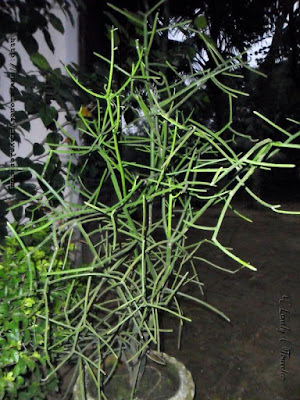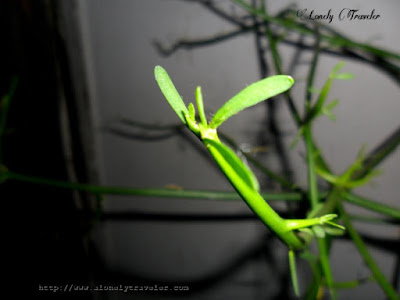| Common Name : | Milk bush, Pencil cactus. |
| Binomial Name : | Euphorbia tirucalli |
| Family : | Euphorbiaceae |
| Bangla Name : | Dudhraj, Dudhshor, Dudhkoshi. |
| Photo Taken : | Bangladesh |
Euphorbia tirucalli is a succulent plant species native to Africa, particularly to Madagascar. It is commonly known as pencil tree or milk bush and is widely cultivated in many parts of the world, including Asia, Australia, and the Americas. The plant has a unique appearance, with thin, green stems that resemble pencils, hence its common name.
Pencil cactus can grow up to 10 meters (33 feet) tall in its native habitat, although it is typically smaller when cultivated in other regions. However, the plant's height can vary depending on the growing conditions and other factors.
This Milk bush does not have traditional leaves, but instead has small, yellowish-green, almost inconspicuous leaves that are shed early in the growth process. The plant's stems are the primary site of photosynthesis, and the leaves play a minimal role in the plant's overall appearance. The stems are thin and cylindrical, and they often have small branches that give the plant a bushy appearance. The plant's sap is toxic and can cause skin irritation, so it should be handled with care.
This plant produces small, inconspicuous flowers that are typically yellow or green in color. The flowers are not the main feature of the plant and are generally considered unremarkable. They are produced in clusters at the tips of the stems and are surrounded by small, leaf-like structures called bracts. The flowers are unisexual, meaning that each individual plant produces either male or female flowers, and they are pollinated by insects such as bees and flies. After pollination, the plant produces small capsules containing seeds that are dispersed by the wind.
Milk bush can be propagated through stem cuttings or by seed. To propagate through stem cuttings, select a healthy stem and cut it at an angle with a clean, sharp knife. Allow the cutting to dry for a few days in a shaded, well-ventilated area until the cut end has calloused over. Once the cut end has calloused, plant the cutting in a well-draining soil mix and keep the soil slightly moist. The cutting should develop roots and begin to grow within a few weeks.
Milk bush has been used in traditional medicine for skin conditions and cancer, but there is limited scientific research on its medicinal properties. The plant's sap is toxic and can cause skin irritation. It contains compounds that may have anti-inflammatory, antimicrobial, and antiviral properties, but further research is needed to understand its medicinal potential.
Photos of Milk bush (Euphorbia tirucalli) were taken from Birisiri (of Netrakona), Bangladesh during December 2011. In Bangladesh this plant is known as Dudhshor (দুধস্বর), Dudhkoshi (দুধকশি), Lonkashij (লঙ্কাসিজ), Dudhraj (দুধরাজ),
Written by Lonely Traveler,
For blog alonelytraveler.com



Where can i get this tree
ReplyDelete